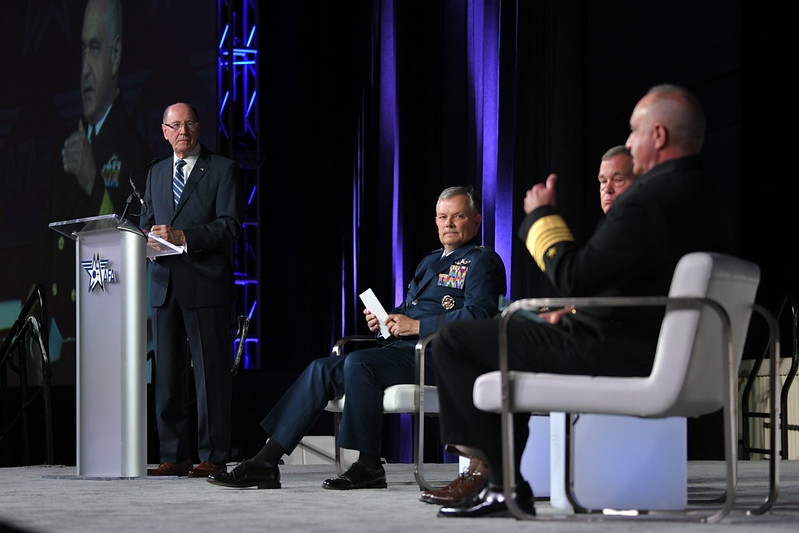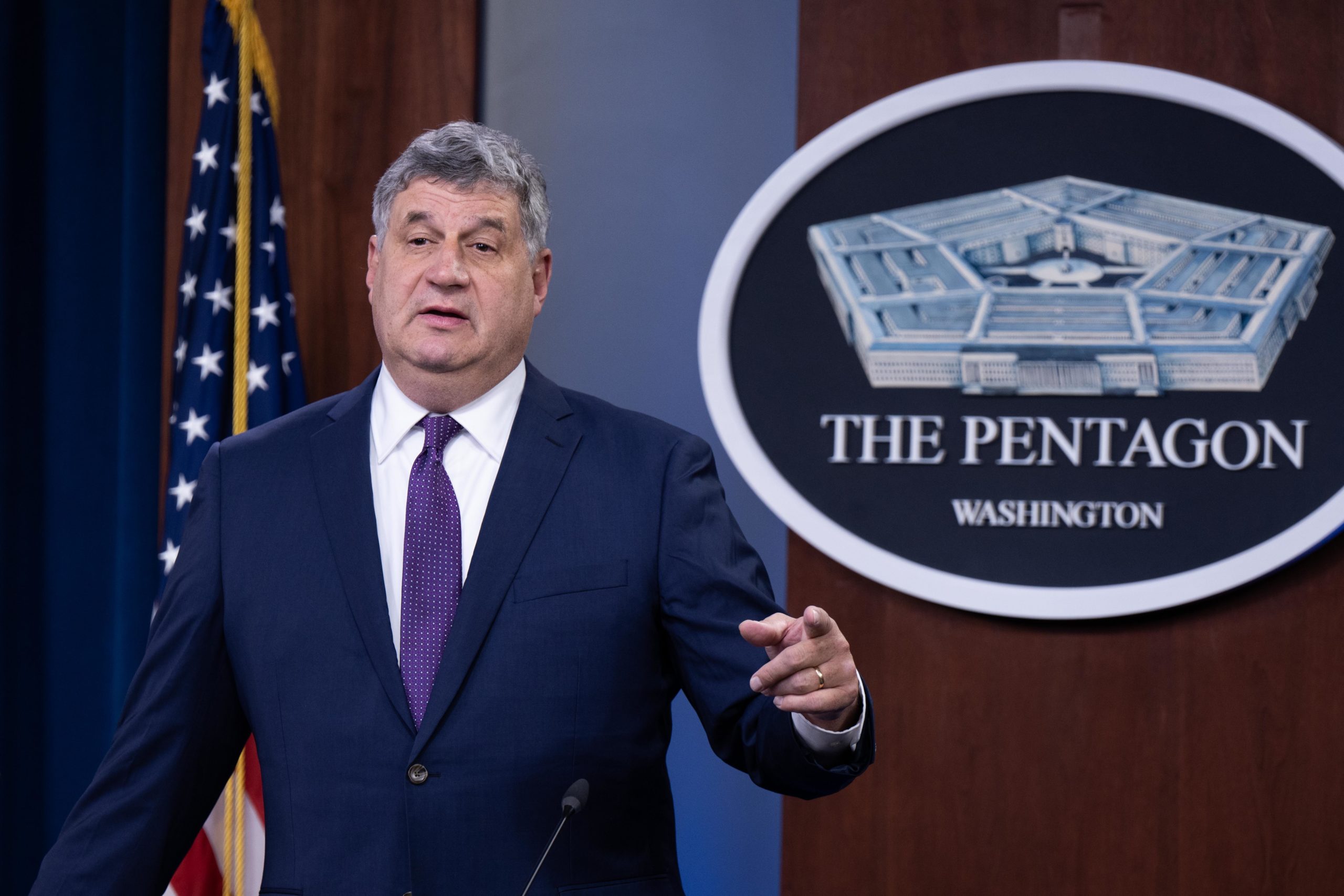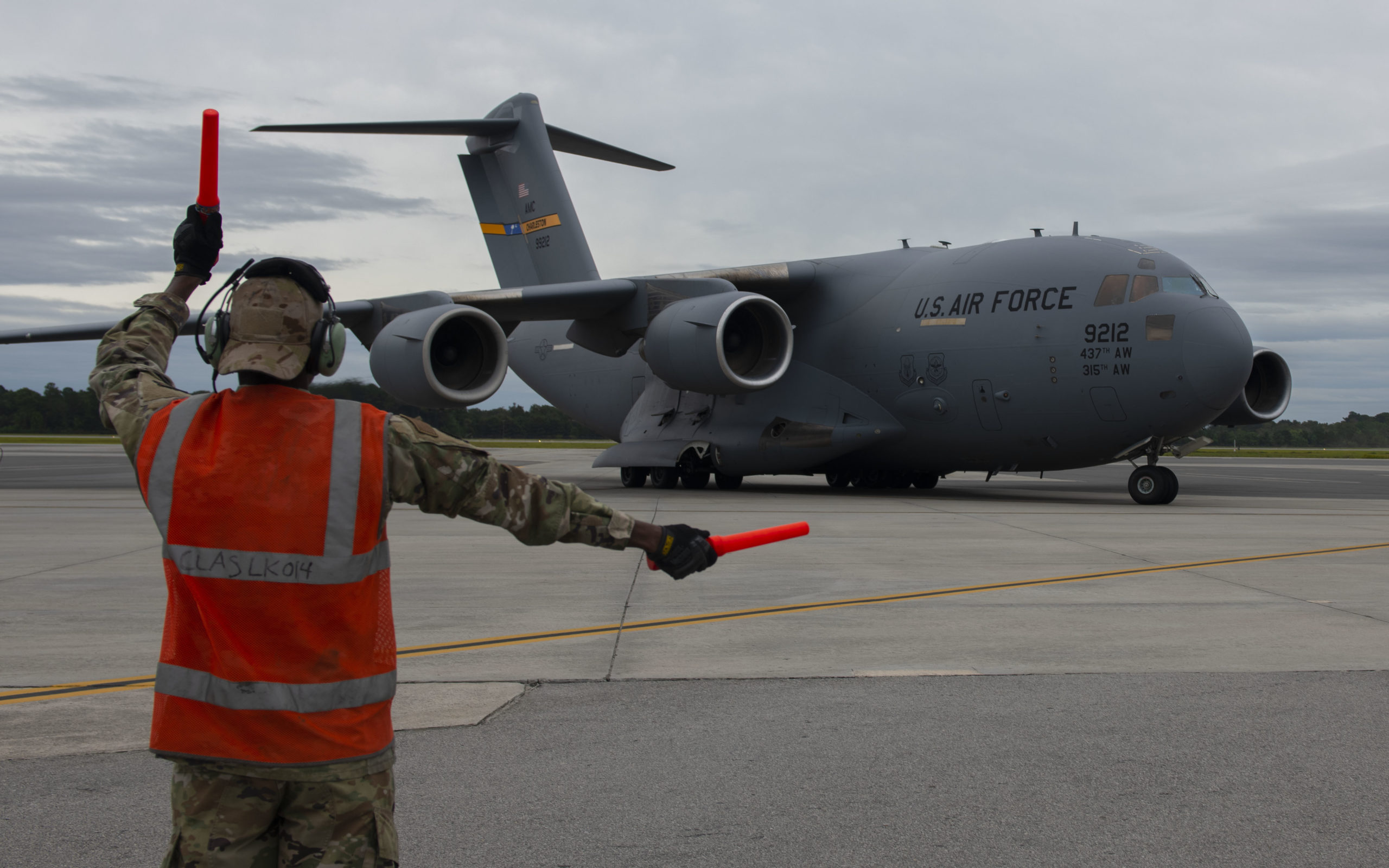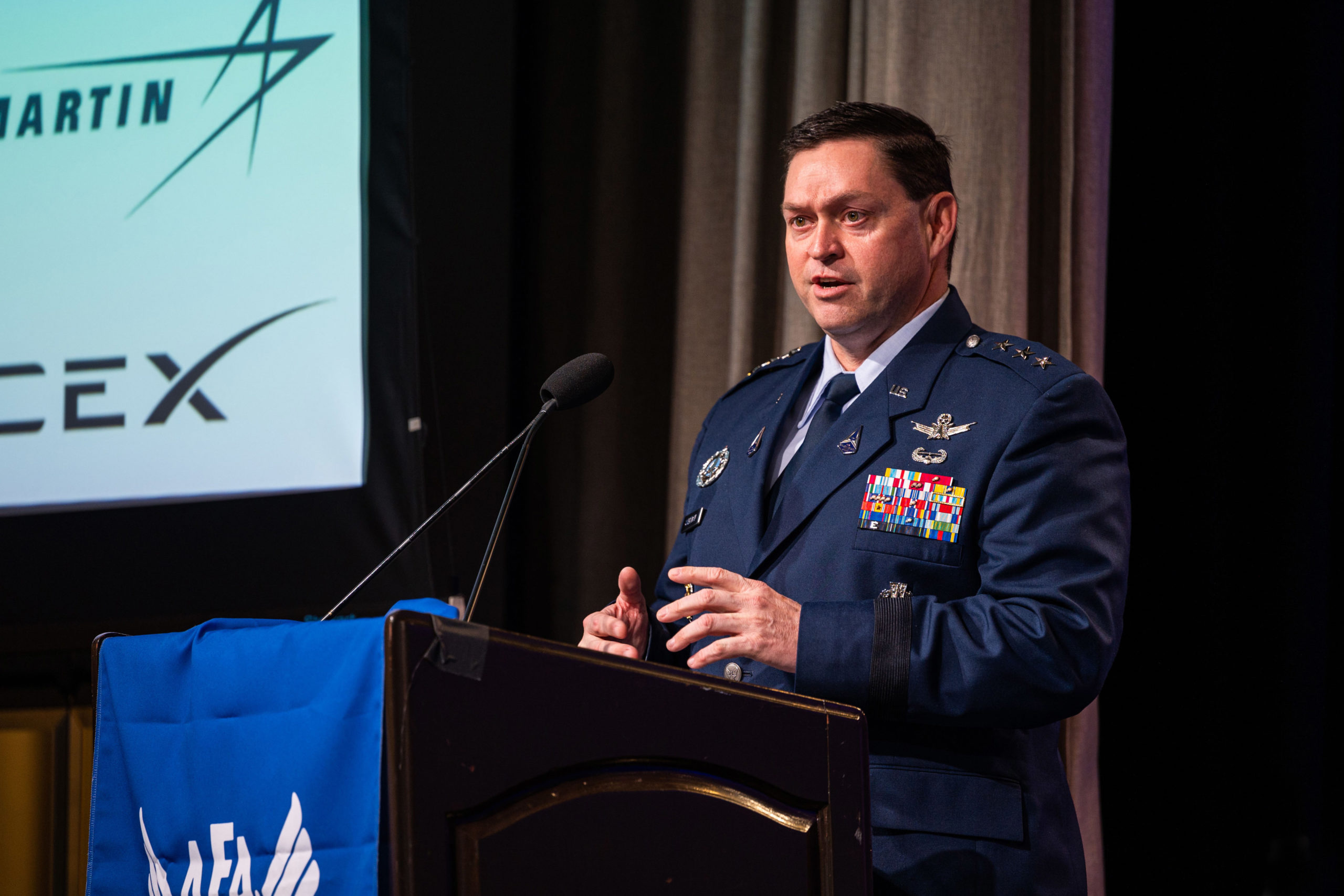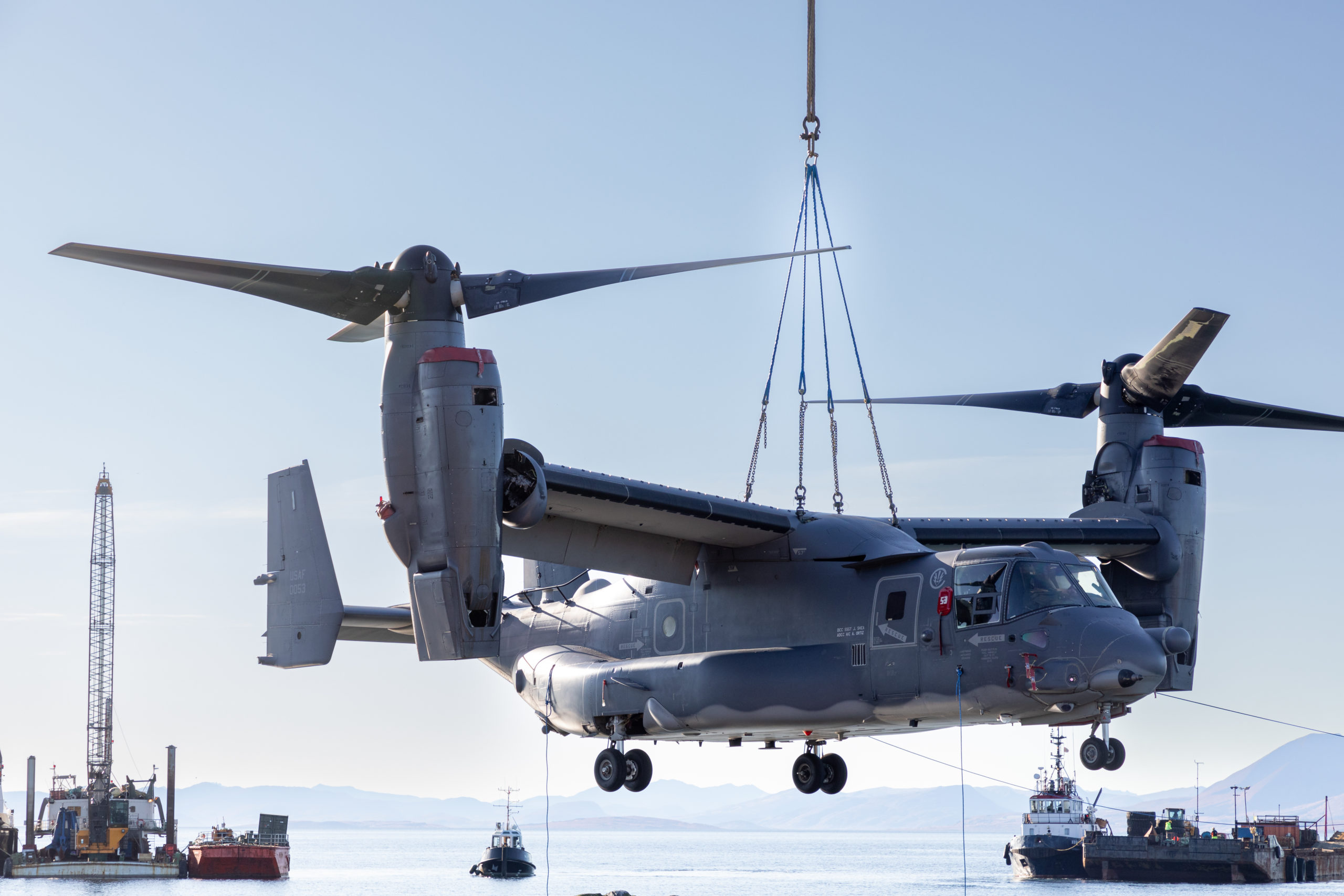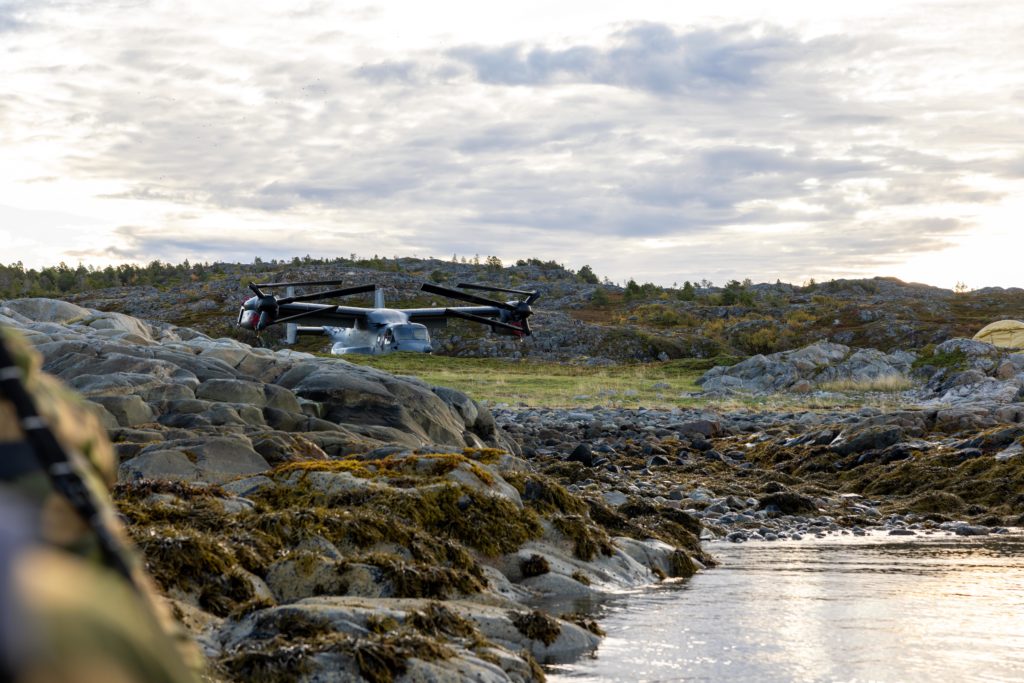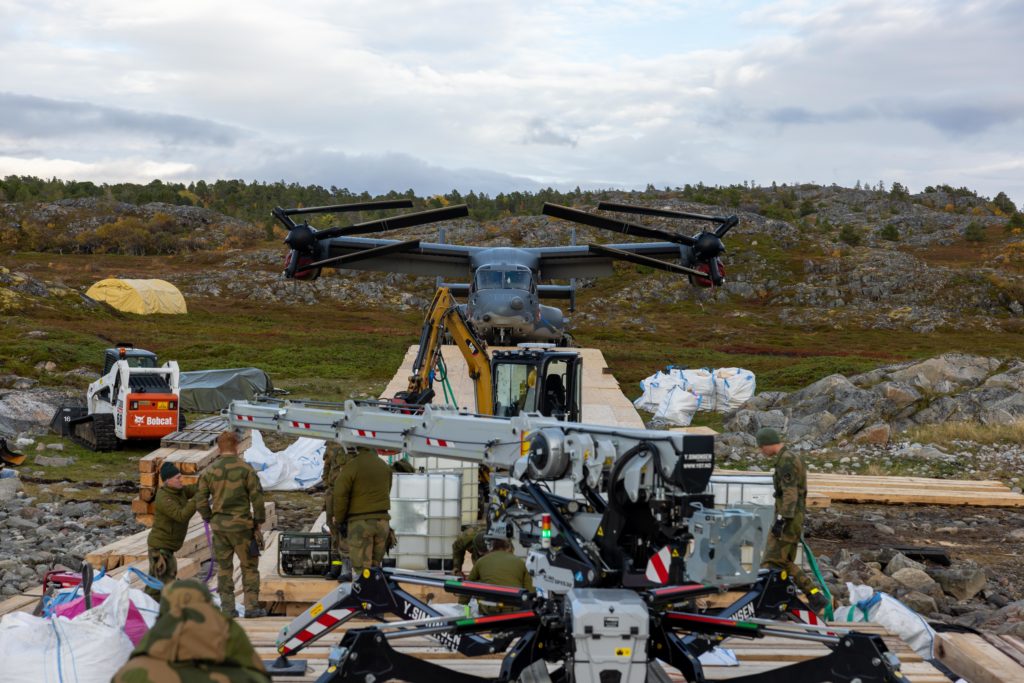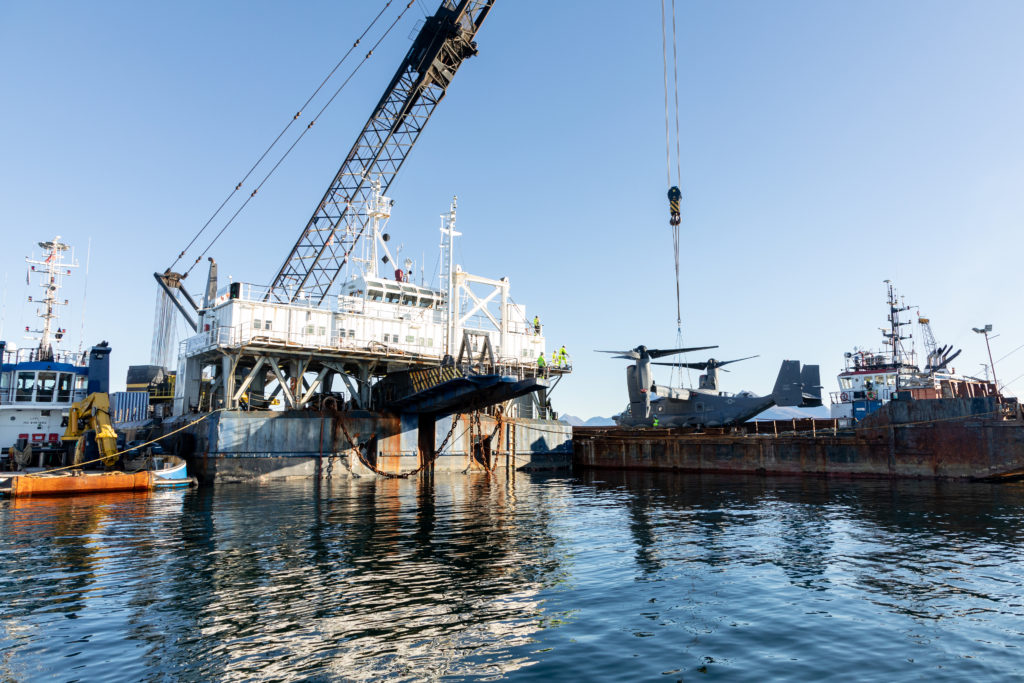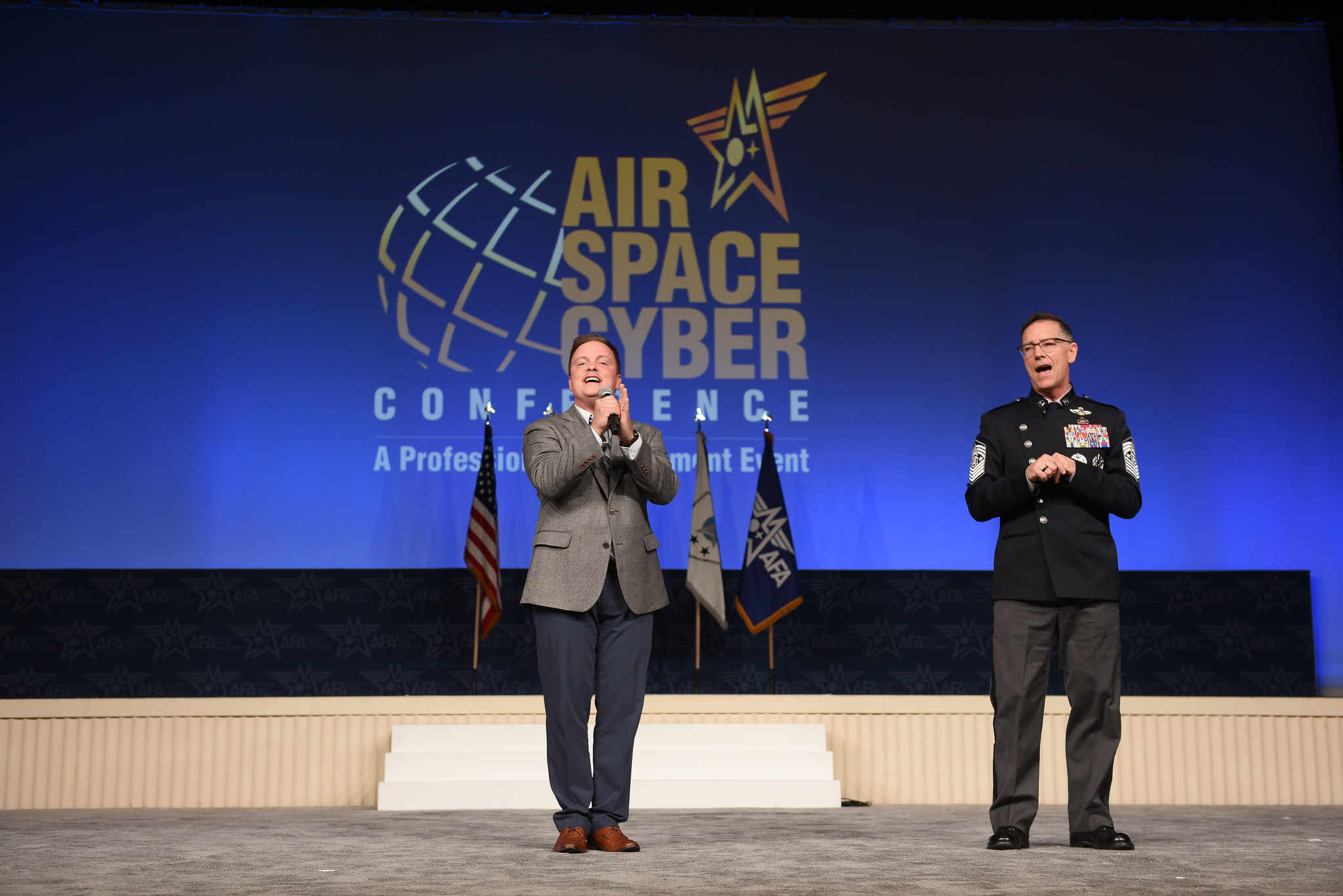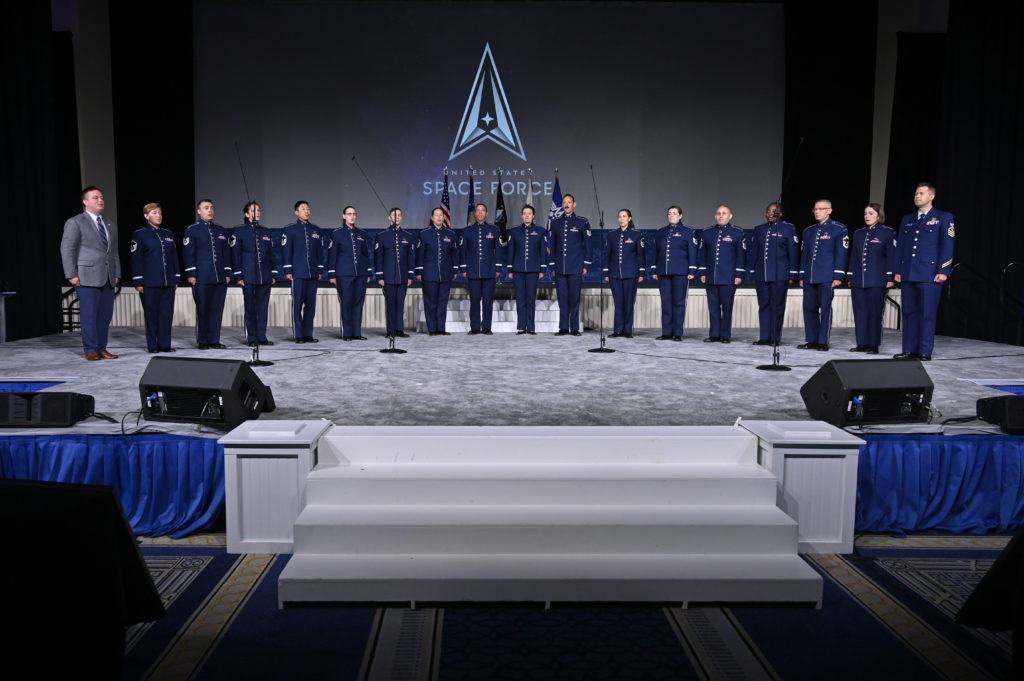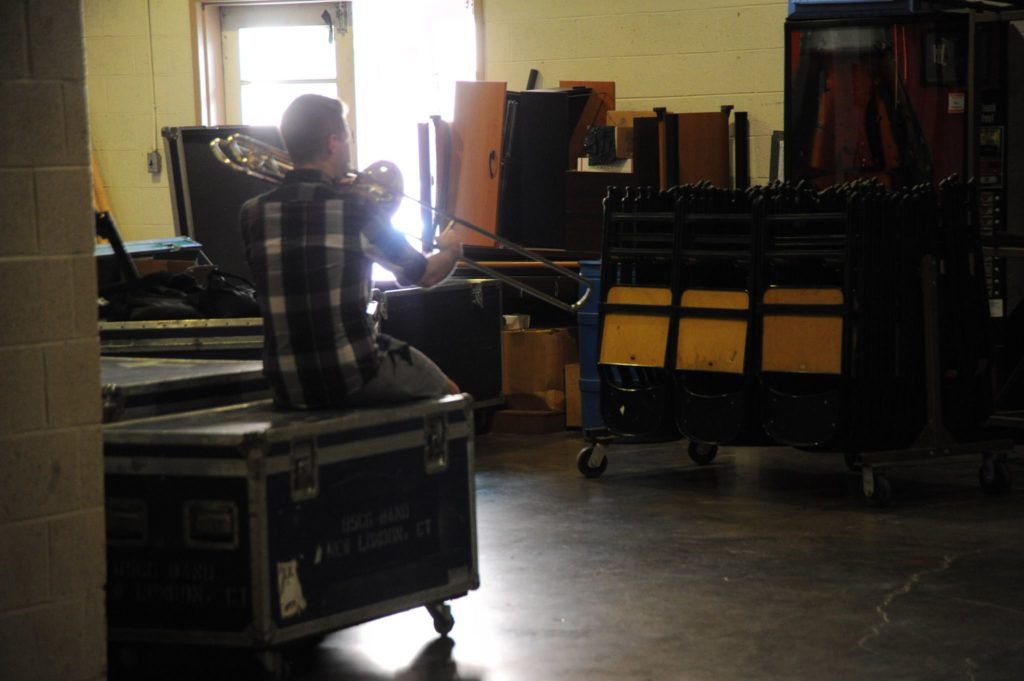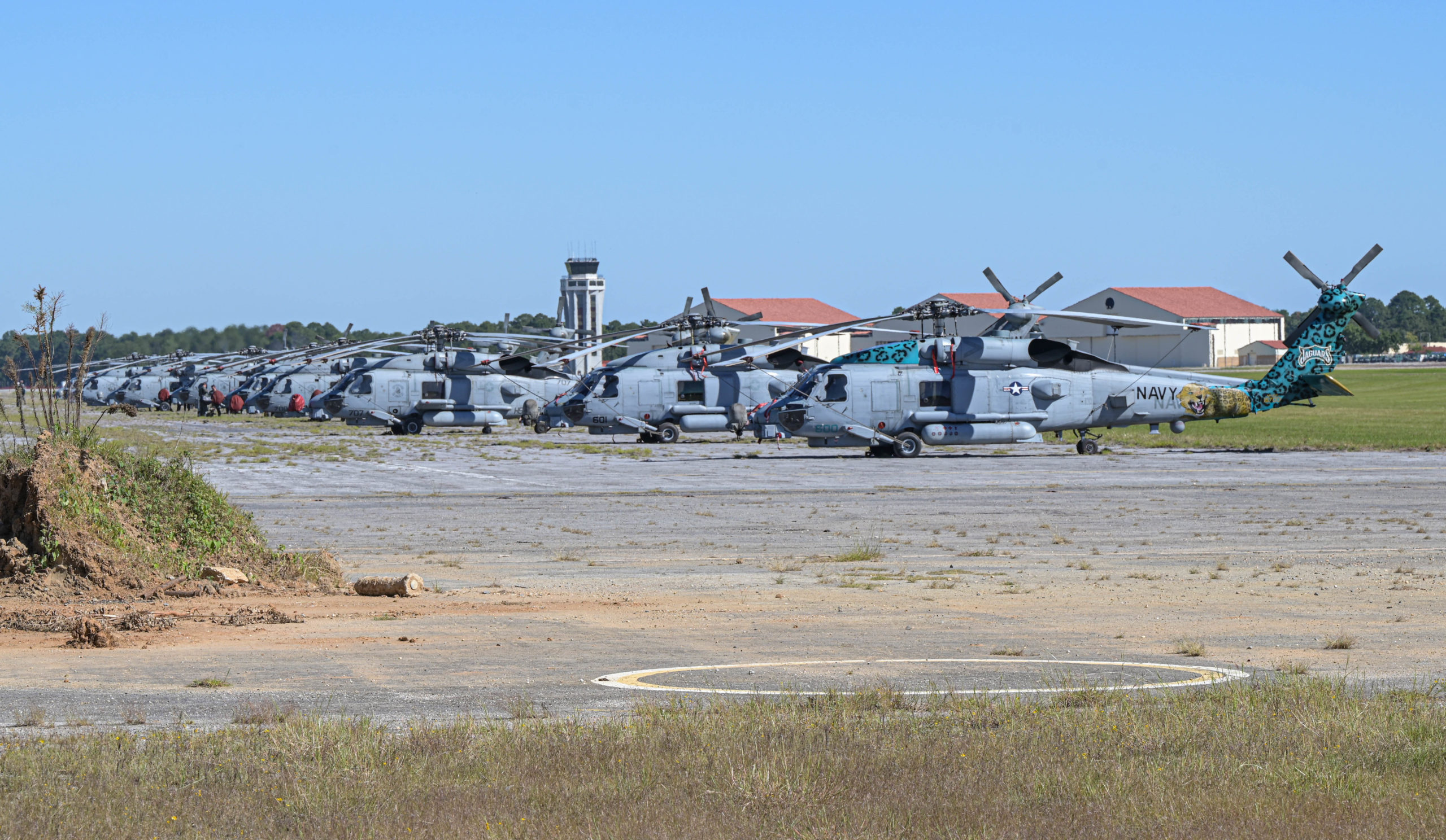Retired Gen. C. Robert “Bob” Kehler led the discussion “America Under Attack: Defending the Homeland” with Gen. Glen D. VanHerck of U.S. Northern Command and North American Aerospace Defense Command; Gen. James H. Dickinson of U.S. Space Command; and Adm. Charles A. “Chas” Richard of U.S. Strategic Command on Sept. 21, 2022, at AFA’s Air, Space & Cyber Conference. Watch the video or read the transcript below. This transcript is made possible through the sponsorship of JobsOhio.
If your firewall blocks YouTube, try this alternative link instead.
Voiceover:
Good morning, please welcome to the stage General Bob Kehler.
Retired Gen. C. Robert “Bob” Kehler:
Good morning everyone. I know we’re still in a bit of a transition here, but it’s a real pleasure to be with you this morning. Welcome to our panel discussion on Defending the Homeland. We have three distinguished warriors with us this morning. I know you’re as anxious as I am to hear their views on this most important subject Today, the United States has 11 combatant commands. Each of those commands contributes to deterrence and each plays an important role in Homeland Defense. To help set the scene for this panel, here’s a bit of personal perspective I gained during my time as a combatant commander. First, modern conflict with a near peer adversary will span global distances, include all five operational domains, and will extend from below the waves to the reaches of space. Second, the scope, scale, and complexity of modern combat means no command can fight alone. To be successful today, 11 combatant commands must act together. Third, mission command, flexible command relationships, and a joint all-domain command and control concept will be the means by which the United States plans, commands, and controls the fight.
And finally, partnerships are critical and unity of effort is essential. Now, Homeland Defense sounds like a very straightforward mission, but in reality, defending our homeland is a very complex endeavor. I can’t think of a group of senior leaders more qualified to address this subject than the three highly regarded commanders on this panel. General Glen VanHerck, the commander of United States Northern Command, General James Dickinson, the commander of US Space Command, and Admiral Chas Richard, Commander of the United States Strategic Command and the people they lead, play critical roles in keeping our nation safe and secure. Gentlemen, we’re honored to have you with us this morning and we’re looking forward to your remarks. Now, in the interest of time, we won’t be taking questions from the audience, so following some opening remarks here, I’m going to pose some questions on behalf of the audience. But as a teaser, before you get started, let me lay one question in front of you now so you can think about it as we proceed. Which command will be the first engaged into conflict with Russia or China? General VanHerck, the floor is yours.
Gen. Glen D. VanHerck:
Thanks very much, General Kehler, it’s great to see you again. Thanks for your service and you continue to serve. I think you teed up the environment very well. It’s an honor to be here with two of my fellow combatant commanders who actually enable Homeland Defense. I would tell you that Admiral Richard is the foundation of Homeland Defense. The nuclear deterrent, strategic deterrence is the foundation of what we do each and every day for defending our homeland. We must have a triad and we must fund it 100% and execute it. I’m also here with General Dickinson who provides my domain awareness for defending the homeland, crucial for threat warning, attack assessment, ballistic missile defense as well. It’s an honor to be up here with you. In my more than three and a half decades, as General Kehler talked about, I’ve never seen a strategic environment more dynamic and complex than the one that we have today.
That environment demands global solutions, all-domain solutions, the mission command that General Kehler alluded to. And to the question that he posed. I would argue that today Cyber Command is engaged each and every day in defending our homeland. We’re under attack in the cyber domain. We’re under attack in the information arena as well each and every day. And so that demands that we think different. I would argue that right after CyberCom, if they’re not the first, that probably SpaceCom is the first place that we would likely see potentially kinetic effects or offensive effects that happen. And simultaneously, I might be supported getting the majority of the force out of the homeland to fight a forward fight, at the same time, Admiral Richard is providing strategic deterrence to enable safety, security of our homeland.
Having one supported combatant commander I think is a thing in the past I think it will change and you’re likely to have multiple supported combatant commanders. I think the conversation today will go down three paths. One of the threat to the homeland and how it’s changed. I think it’ll go down to deterrence and looking at deterrence differently. I think the National Defense Strategy has it right, integrated deterrence and hopefully we’ll talk a little bit more about that. But if deterrence does fail, what does defending our homeland look like today? And hopefully we’ll get a chance to talk about that. General Kehler I look forward to the discussion. Thanks.
Gen. C. Robert “Bob” Kehler:
Thank you. General Dickinson, you command the newest of the three commands represented here on the stage and, Sir, the floor is yours.
Gen. James H. Dickinson:
Well, thank you very much, General Kehler, for moderating this group up here on the stage this morning. It’s no easy task to keep three combatant commanders in line for 40 minutes, so thanks for what you’re doing and I think this is our second time together and thanks to AFA for having me here today. It’s always good to be a Soldier on the stage with a Submariner as well as an Airman. It is an honor to be here. Thanks for the invite. And then to my two colleagues here on the stage, we both smile, we spend a lot of time together, and I’ll talk about that just in a minute. It’s an honor to be with Glen and Chas today on the stage. Let me just touch on the strategic environment for a minute. It is absolutely changing in the space domain. When I categorize it in terms of a congested, competitive, and contested areas or buckets, if you will, it’s pretty amazing how it’s just changed in the three years since US Space Command has stood up.
And so we just turned three and I wanted to congratulate the Air Force in terms of their 75th birthday. We’re not quite that old. We’re three, but just in those three years, if I were to tell you how congested it is now, you would be quite surprised that when we stood up it was about 25,000 pieces of debris, objects, old satellites, new satellites that we track each and every day by some great Guardians out at Vandenberg Space Force Base. But in three years, that number has gone from 25,000 to over 47,000, just in three years. That gives you a feeling for how congested it is becoming. And of course I can talk more in depth later during the Q&A about how we’re getting after being able to manage that.
The second category is competitive. In my mind, a good news story when you look at the absolute expansion of the commercial industry into the space domain and what that means to all of us in this room and all of those that are on the camera in terms of how that’s improving our quality of life, whether it’s quality of life at home, business, entertainment, all of those things together. It is amazing to see how that is in fact maturing and growing each and every day. Then the third category would be contested. And so I know this week there’s been several panels where they’ve talked about what the space threat is today and what our competitors are doing in the space domain, but I think it’s very important that we remember that we’ve just seen a couple of demonstrations just recently by both the Russians and the Chinese in terms of their capabilities that they’re building and testing to hold our assets at risk. Most notably we saw back in November where the Russians destroyed one of their own satellites in orbit producing more than 1500 pieces of debris.
That adds to that 47,000 that I just mentioned earlier. And you have the Chinese as well with the SJ-21 a couple of months ago, which was in our eyes, a dual-purpose capability that’s able to secure satellites and move them around in orbit. And so they used it to move one of their defunct satellites out past Geo and then came back in, but did it in a very interesting way. Just those two examples right there show you that it is becoming more contested in the domain. When I look at the NDS, I think we’ve got it about, I think it’s about right for us in terms of combatant commanders. This integrated deterrence concept that we’re operationalizing now every day I think is a very important piece to our national security strategy and how we’re doing that each and every day. And these two gentlemen on my left and right, we work together along with our other eight combatant commanders, joint staff, and partners in order to make sure that we’re doing that each and every day.
And when you look at integrated deterrence, US Space Command looks through it through the lens of our operational approach, which is partnering with our joint force, our allies, as well as our partners in the commercial domain as well as the IC. We’re working very hard at that each and every day. What’s new with US Space Command from the old space command, we’ll talk a little bit more in the Q&A as how we’re in a supporting and supported relationship at this point. My support to these two gentlemen on my left and right and the other combatant commanders in terms of providing space enabling capabilities is not new and we’ve been doing that for many years. What is new is that these two gentlemen on my left and right now have the ability to support me in what I do in the space domain each and every day. The supporting supported relationships are critical to what US Space Command does today and in the future. And with that, I think I’ll pause. Thank you.
Gen. C. Robert “Bob” Kehler:
Thank you. Admiral Richard, StratCom. What more can I say? The floor is yours.
Adm. Charles A. “Chas” Richard:
Hey, so General Kehler one, I do want to assure you that we’re taking very good care of your command. You’d be happy with what the kids are doing. I do want to thank AFA for giving us this opportunity the whole week in addition to this opportunity to talk about Homeland Defense with two of my distinguished peers. Let me state up front that I just am not going to be able to get into much of a current operations discussion about what’s going on in the Russia Ukraine crisis. I think you would understand that, but that does point to something that I think is foundational here, which is all of us in this room are back in the business of contemplating competition through crisis and possible direct armed conflict with a nuclear capable peer. We have not had to do that in over 30 years. The implications of that are profound. They’re profound for homeland defense, they’re profound for strategic deterrence, as well as us achieving national objectives.
And this is no longer theoretical. I will point out that I can’t get through a week without a reminder that this is a very real threat that we face. I’m going to concentrate on the strategic and nuclear dimensions of this. I absolutely agree with General VanHerck that it is foundational to homeland defense what my command and my forces do, but it’s foundational to everything else. And a way to think about that is every O plan in the Department of Defense, every one of our plans and every one of our other capabilities rest on an assumption that strategic deterrence and in particular nuclear deterrence is holding. And if that assumption isn’t met, nothing else in the department in the joint force is going to work the way that it was designed. And I don’t think we fully understand that. Russia and China can escalate to any level of violence that they choose in any domain with any instrument of power worldwide. We just haven’t faced competitors and opponents like that in a long time.
And it changes everything about the way we have to go do business. We will have to deter across that spectrum immediately. Contests between nuclear cable great powers are quickly less about the region. They are less about the order of battle comparison, whose kill chain’s going to close and whose skill chain’s not. And they quickly become strategic issues. Who judges greater stake? Who’s willing to take greater risk, including possibility of nuclear risk to achieve that stake? That means our traditional approaches don’t work anymore. I want to highlight what General VanHerck just said. The days of whatever your problem is, throw a JOA around it, put a commander in charge of it, shovel resources and tell everybody else they’re supporting they’ll go solve your problem, those days are over. We will have multiple supported simultaneous commanders simultaneously defending the homeland, maintaining strategic deterrence, achieving our objectives against the opponent in the region, maintaining freedom of maneuver in space and in cyber space. We have to just think radically differently.
I could keep going, but I won’t in the interest of time. Our concepts of escalation control are flawed. Maybe we can get to that in the questions. The final thing I want to add is we absolutely think integrated deterrence as both of my fellow CoComs just mentioned, that is the right answer. I’m the third or fourth StratCom commander that has called for this. But the point I want to make there is how foundational nuclear deterrence is to integrated deterrence. If you back up integrated deterrence and use every other capability we have to influence the opponent’s perceptions and decisions, of course it’s a great idea. Of course, it’s exactly what we have to do. But if you don’t underpin it with nuclear because there is no other capability or combination of capabilities demonstrated to date that gets anywhere close to the demonstrated destructive potential of nuclear, if you don’t underpin integrated deterrence with your strategic forces, the whole concept doesn’t work. Sir, I’ll stop there. I look forward to the discussion.
Gen. C. Robert “Bob” Kehler:
Thanks. Gentlemen, I’m going to pull on a thread that each of you has touched on and I think that it bears some expansion to set the stage for how you’re approaching some of your requirements for capabilities that you need. There was a time when strategic and nuclear were used synonymously and where the threat to the homeland was really defined by nuclear threat to the homeland. That’s vastly different today. Can you say a word about the threats that you’re facing today?
Gen. Glen D. VanHerck:
Absolutely. Let me approach this from the two hats I wear and the missions that I’m assigned. As a NORAD commander, my first mission is to provide aerospace warning for North America, things that fly in air, things that come from space, pretty simple. As NORAD stood up, it was pretty simple. Bombers flying over the pole, delivering gravity weapons on our homeland. ICBMs that come from nations to the homeland. We’ve been there for many decades. Today, the aerospace warning challenge is dramatically different. Cruise missiles with very low radar cross sections that can be fired from vast differences, including over Russia and far out into our oceans that are a domain awareness challenge for me. Fractional orbital bombardment vehicles with hypersonics that can evade our radar detection capabilities, which are crucial for strategic stability and the responsibility I have for providing awareness for continuity of government, for force posturing of nuclear forces.
All those are dramatic implications on strategic stability. That’s just aerospace warning. Couple that with submarines sailing around, now in both the Atlantic and the Pacific capable of firing nuclear or conventional cruise missiles, including hypersonic missiles, at the homeland, creates another unique challenge for aerospace warning as well. Under aerospace control, my second mission in the NORAD command hat is if it is a threat to the homeland, specifically in the air domain, is to render that threat incapable of rendering effects on our homeland. That’s a significant challenge for domain awareness to be able to provide forces that can get after those cruise missiles, whether they come from submarines, surface vessels such as caliber capable shooters, ground land attack capable right across the strait from Russia, or from vehicles on space orbit. You name it there, there’re significant challenges and having access to forces on a day to day basis.
The way we’re set up to provide me forces is through a request for forces mechanism, which assumes that there’s no threat to the homeland and we’ll have time to be able to request those forces and get them in place to set the AOR. I would argue that I’m the achilles heel to enabling either the commander of EUCOM or the commander of INDOPACOM to execute their plans because if I’m not ready to defend the homeland from the threat, it’s a significant challenge for me. Maritime warning is another mission I have in my NORAD hat. Right now, we just got within the last couple days, Sev-class submarine in the Pacific for the Russian fleet. They’re on their way to building nine, which means that we’ll have persistent proximate threat in both the Atlantic and the Pacific fleet for the Russians here in the near future and China’s about five to 10 years behind.
That threat is dramatic. I’ll shift over to my NORTHCOM hat in Homeland Defense. Primarily what you think of there is ballistic missile defense. I’m pretty confident in my capability today against the North Koreans. I’m not tasked to defend against China or Russia from a ballistic missile threat. That’s this gentleman’s job right down here. But it’s a significant challenge when you don’t have the domain awareness against those hypersonics to provide the threat assessment. Other things, homeland defense. In my cyber role, I’m the DSCA synchronizer to provide support by DOD to either CISA or other entities. And so I work very closely with CyberCom, General Nakasone, to do that. I’m candidly worried about the cyber threat. I think it’s the most likely threat and the one where I have likely the least domain awareness today. General Nakasone only defends the DODIN.
Jen Easterly is the director of CISA, defends other federal entities. Everything else which could be critical infrastructure in our United States, which we rely on to project power forward for command and control capabilities is a “play if you want.” There’s a lot of work to be done there as well. On my DSCA role, I just talked about it a little bit, environmental change will continue to challenge us. That is a threat. I think that my DSCA role is part of Homeland Defense. It’s part of demonstrating readiness, responsiveness, capability, and resiliency each and every day. I think that’s crucial. The most significant thing about environmental change is what it’s doing in the Arctic and what Russia and China and others are doing in the Arctic to hold our homeland at risk to change international norms, rules, and laws so that they can get access to minerals and those kinds of things.
That’s a great area for competition today. And the final thing I’ll tell you for the threat is the threat of transnational criminal organizations just south of our border and in the western hemisphere. What you see in the news is the symptom of those. Those are law enforcement challenges for the most part, counter-narcotics, human trafficking, human migration. What I’m most concerned about from a national security imperative is the instability that transnational criminal organizations create right here in our own hemisphere that China, Russia, and others are taking advantage of to gain access and influence here. Very dynamic environment.
Gen. C. Robert “Bob” Kehler:
General Dickinson, can you expand a little bit? You had mentioned the words competitive and congested and contested. Can you say a word about contested? You spoke a little bit about that, but there seems to be a pretty significant change in the contested aspects of the space domain.
Gen. James H. Dickinson:
Absolutely. First of all, we’re talking about homeland defense and NORTHCOM. From a US SpaceCom perspective, our AOR starts at 100 kilometers and then goes out to the edge of the universe. And so when we talk about support to other combatant commands, we really have a global responsibility. And so assets that may not geographically be over the NORTHCOM homeland defense area could be elsewhere in orbit providing those same capabilities. We have a responsibility to provide global capabilities to each of the combatant commands. And as such, we’re watching very closely as our competitors are expanding their capability and capacity to hold at risk those capabilities that I require to provide to, in this example, Glen VanHerck, whether it’s satellite communications, missile warning, or GPS.
And so I would characterize it as aggressively growing in capability and capacity by China in terms of how they are developing their capabilities to do things that we’ve been doing for quite some time in terms of global type of capabilities over the horizon, for example, or joint kill chain. We’re watching that growing in both capability capacity and I would characterize Russia as not proliferating at quite the rate that the Chinese are, but that is something that we watch each and every day. I gave you an example of the SJ-21. Really those are capabilities that we watch very closely because they would hold at risk some of our assets not only from a military perspective, but also from a commercial perspective. That’s how I would characterize it without going into too much more detail.
Gen. C. Robert “Bob” Kehler:
Admiral Richard, same question for you, but I’m going to add something because we’ll come back this way for the second part of this, which gets into the capabilities that you need given these threats that have advanced and are now much broader than the nuclear threat that we face. Say a word about the threat and then say something about the capabilities.
Adm. Charles “Chas” Richard:
Well, General, and for the audience, I hope you all can see from our answers up here between us three CoComs this is not the first time we’ve talked about this between each other and it gives you evidence of how, and it’s not just the three that are here, we’ve been thinking about this a lot. You may have noticed when I made my opening statement, I drew a distinction between strategic deterrence and nuclear deterrence. Those are two different things. My colleagues up here have given you some examples of threats that have strategic implications. To your point, General Kehler, earlier back in the Cold War, it was pretty much only nuclear. That’s not true anymore. And that gets into, we have to think through how we’re going to deter that. And my forces aren’t always the answer. It isn’t always cost imposition. General VanHerck has talked about this, that nowadays sometimes it’s denial of benefit through resilience, through defense.
Sometimes it is cost imposition. We need to rethink, get much more fluent at how we do deterrence. And our operational level expertise in deterrence has really atrophied. We have few enough people that can write the paper, particularly when you’re trying to deter two peers at the same time. We have even fewer people that know who needs to get ordered to do what in order to accomplish it. And so many things we need to rethink. Avoiding provocation is not deterrence. Restraint in regional operations alone will not maintain strategic deterrence nor will it defend the homeland. There’re going to have to be other actions, postures, and effects to achieve those goals. Capabilities, I’m in the fortunate position that the Nuclear Posture Review that was recently delivered laid out an excellent strategy.
In terms of base capabilities, it was an endorsement of the need to recapitalize the triad for the base capabilities along with nuclear command and control in our weapons infrastructure. We’re going to need to look at that as the absolute minimum stack of capabilities that we need and much more frequently ask ourselves as a nation, what is the capability, capacity, and posture we need to execute this very good strategy as the threat from China continues to increase, we don’t know where that’s going to end, as the threat from Russia continues to increase, along with the other challenges that we face. Triad is the absolute minimum. Got to ask ourselves that question much more frequently.
Gen. C. Robert “Bob” Kehler:
And General Dickinson capabilities that you are going to rely on to meet the threats that you laid out.
Gen. James H. Dickinson:
Capabilities, well I tell you. We approach it from a perspective of how do we use the ground link and the spacecraft in order to look at how we’re both defending as well as looking at our adversaries and our competitors. How do we look at that system gives us the capabilities when we talk about integrated deterrence to have both in this example, cyber, SOF, and space coming together in order to provide effects and capabilities that we need to do when we look at both defensive as well as offensive type of operations.
Gen. C. Robert “Bob” Kehler:
You defined your AOR as reaching to the edge of the universe. That’s pretty broad. Do you have the surveillance capabilities that you need?
Gen. James H. Dickinson:
One of the challenges that we work on each and every day at US Space Command is how do we improve our domain awareness? I think Glen VanHerck talked about it in detail and one of the priorities within the command right now is how do we improve our ability to see into space? How do we understand where those 47,000 pieces of objects, whether it’s an old, new spacecraft, debris, whatever the case may be, commercial assets, how do we improve that? And so we’re looking at how do you improve that today? Because I know we’ve got things that are coming in the future and I’m very optimistic about that, very eager as an impatient combatant commander to get new capabilities. But what do we do today with what we have?
And so we’ve really over the last couple of years, looked at how we leverage assets and sensors that weren’t traditionally part of the space domain awareness architecture. We’re leveraging, for example, TPY-2s, ships, other sensors that are part of other architectures, if you will, within the department. How do we bring those capabilities to bear in an integrated, the objective is to be integrated, at least interoperable at this point, or at least to have them as part of the architecture so we can understand better what’s going on in the space domain. It’s absolutely critical. Just like in any other domains, you have to absolutely understand the domain and what the activities in order to do what? Characterize and then present those types of options, decisions, informations to the National Command Authority so that they can make informed decisions.
That’s really what we’re working on. That’s one of the top priorities within the command. Again, I said we’re looking forward to the new assets, new capabilities that are coming forward here in the future, but we’re working today to make sure we’re leveraging to the maximum extent possible, the capabilities that exist today, and quite frankly, we’ve paid for. How do we do that is the challenge and we’re working on that every day. Great support that is not only within the Department of Defense. We’re also looking at commercial capabilities and how they can contribute to that same awareness situation that we’re looking to improve.
Gen. C. Robert “Bob” Kehler:
General VanHerck, how about capabilities from your perspective? And let me add one other thing to that. Each of you has mentioned cyber security. Would you say a word about cyber security and your command and homeland defense?
Gen. Glen D. VanHerck:
Yeah, absolutely, General Kehler, thanks. Well, domain awareness has been talked about multiple times. For me, that’s been the top priority and consistent for the 25 months that I’ve been in command. You certainly can’t deter something and you absolutely cannot defeat something if you cannot detect it. When I talk domain awareness, I’m talking undersea, on sea, land, air, space, and cyberspace and having more awareness of what’s going on. I’m encouraged the department directed the Air Force to go fund over-the-horizon radar, four over-the-horizon radars for me, which will give me significant domain awareness for standoff from both maritime, air, and space capabilities. The domain awareness from undersea, I think, needs some additional work, especially in the Pacific. The days of laying cable on the bottom of the sea are something that in the future I don’t think we can do as well in the Pacific.
And it demands us to think differently about that using space capabilities, more mobile capabilities to give us domain awareness as well. But I would tell you that, Gerald Kehler, today all too often we have the domain awareness we need. It’s just not shared and it’s in stovepipes, so it’s left on the cutting room floor. The days of building single stove pipe systems for ballistic missile defense, for example, should be over. We should develop a system capable of providing domain awareness all the way from small UAS to space capabilities and then sharing that domain awareness. I talk about domain awareness as my top strategic priority. The second thing would be information dominance. What do you do with that domain awareness and how do you process it and do you process it in timely manner? What I’ve seen is about 98% of our domain awareness is left on the cutting room floor today and not even analyzed.
I think that we need as a department to move quicker in fielding JADC2 capabilities. We’ve demonstrated the capability exists today to do that. The strategy we have, you’ve heard us all talk about global, all-domain, demands that we go down this path. We can’t take and analyze things for days and hours. We need to have near-real-time, on-orbit analysis that shares and provides information with machine learning and artificial intelligence. That’s how we gain decision space. The one thing that I can never have enough of is time. And I need time to give to the President, the Secretary, the Prime Minister in Canada, the Minister [of Defence] as well. And we have to go down the path now, not only sensor to shooter, which is primarily where the services are focused. I’m talking about sensor to decision maker, domain awareness capability so that we can stay out of conflict and actually deescalate in crisis and compete day to day.
But where everybody’s going is sensor to shooter and we are too focused on conflict. We need to be ready for conflict, but we also need to be focused on the sensor to decision maker and executing the national defense strategy. Sorry, but I’m going to take a little bit more time while you give me the bully pulpit here. We’re too risk averse folks, especially in the development of capabilities. China fails and they get back on the horse and they ride. We have a two year congressional investigation when we have a failure. That’s not going to create capability in the timely manner that we need it. The department is an Industrial Age focused department in the development of capability. We’re great at building ships, building planes, tanks, those kinds of things. We’re not great at the digital environment that we operate in today. And we need to think differently about how we field capabilities.
A five year FYDP with a budget where colors of money can’t cross, probably needs to be reconsidered. For example, I update my software every 14 days. If I want to do things in the year of execution, I have to go ask Congress. That is not getting us to field capabilities in a timely manner. I think there’s much more that we can do there. And we need to be organized, trained, and equipped to operate throughout my whole AOR. I’m from the North Pole to Central America, from the Central Atlantic Ocean out into Pacific. I can’t get forces to operate in the Arctic because they’re not available to me because we’re not organized, trained, and equipped. And if I do, oftentimes they’re incapable of operating in that environment. We should not cede that space to Russia or China. Those are capabilities that we have to look out for in the future.
Gen. C. Robert “Bob” Kehler:
I’m going to stay with you for another second. All three of you made some comments about the complex network of partners that you have to have and that you’re relying on today. You have an audience here with many of your partners in it. What can you say about partnerships, and in particular, what can you say about the role that commercial providers are playing today for your kinds of operations? It applies to all three of you of course, but let me start with you, General VanHerck.
Gen. Glen D. VanHerck:
Well first of all, I think our asymmetric advantage is our network of allies and partners around the globe, something that Russia and China don’t enjoy. That’s something that we have to take advantage of. I would tell you that my Homeland Defense Design does not start in the homeland. It starts with allies and partners forward. I want to generate effects forward before the threat becomes a threat here in the homeland. Shooting down cruise missiles over Washington DC or over Ottawa in Canada is failure in my mind. We need to generate those effects forward. Same thing with my fellow combatant commanders. Their relationships there need to generate effects forward. My layered defense design is to focus on where we’re going in day-to-day campaigning as well.
And that includes our allies and partners. Most importantly for me, what I would tell you on the relationships and the partnerships is for me in the homeland, the interagency partnerships that I have are crucial. They’re crucial not only for my defense support of civil authorities mission, but more and more day-to-day for campaigning and the ability to demonstrate readiness, responsiveness, capability, and resiliency across all agencies of the interagency, our government with our allies and partners is crucial to integrated deterrence. My goal is to get in the gray matter of anybody that would ever think about attacking our homeland and make them believe that they could never bring us to our knees and be successful with that. That’s just not a DOD problem—that’s a whole-nation problem.
That takes beyond the federal government as well as it takes all of us to understand and approach that problem that way. You asked me about cyber and I failed to answer that question earlier. My relationship is crucial. They’re partners with me in CyberCom. We’re in the process of right now of figuring out defense critical infrastructure and where we must defend. And that’s not only inside the department. There are second and third order effects outside the department, municipality, states, key industry partners that we have to partner with that create vulnerabilities in the homeland. That goes back to the relationships you just discussed.
Gen. C. Robert “Bob” Kehler:
General Dickinson, your partners, I know that the Space Force and your other uniform partners are stressing the importance of commercial providers these days for space related things. Can you say a word about them and your relationship and the importance of that partnership?
Gen. James H. Dickinson:
Absolutely. That is an absolute key element of my triad of joint, combined, and partnered approach to what we’re doing each and every day. The commercial piece is absolutely integral and huge in terms of what we do each and every day. It’s not new to US Space Command and Space Force for that matter. We’ve had a good relationship out at Vandenberg Space Force Base for years in terms of having our commercial integration cell out there and commercial partners partnering with this out there. But we have expanded that. We’ve expanded that now to where we’re using commercial capabilities to help me with the problem that I told you about earlier, which is space domain awareness. Our commercial partners that are able to actually have telescopes and capabilities and sensors that can look up and report out to us is critical in what we do. They can be in parts of the world that we need them.
Because in the space business, it is all about location, location, location in terms of making sure that we have capabilities worldwide that are able to help us determine and monitor what’s going on in the space domain. We continue to improve that. There is a lot of energy right now within the command to bring more commercial partners onto the team so that we can expand not only space domain awareness, satellite communications, as well as some of the other things that we’re doing. It’s a very optimistic view in terms of what we’re seeing in the commercial industry today. I think we can all agree to that when you see some of the capabilities that have been demonstrated just since the 24th of February over Ukraine in terms of what the commercial market can provide. Those are the capabilities that we absolutely need to continue to leverage and incorporate into what we’re doing each and every day.
Gen. C. Robert “Bob” Kehler:
Gentlemen, I have a lot more questions that we could spend the next couple of hours here discussing, but we’re running out of time. Admiral Richard, let me start with you. Is there anything else that you’d like to mention to this audience as we wrap this up?
Adm. Charles “Chas” Richard:
Yeah, the final thing I’d offer for, this session has been a fabulous session, is I want to emphasize something General VanHerck was just talking about the need to go faster in our capability acquisition. And the way we have to go about doing that is to quit asking how we’re going to mitigate our assumed failure in anything and turn the question around to what’s it going to take for us to be successful? General Kehler, those partnerships you talked about, particularly with commercial, that’s where your innovation comes from. Go look up the Hound Dog AGM-28. This nation’s SAC went from zero to an 800 mile Mach 2 capable cruise missile with a one Megaton nuclear warhead and really good accuracy for the day in 33 months. Go look at how we used to go approach these things. That’s the model on what we’re going to have to do in the future.
Gen. C. Robert “Bob” Kehler:
General Dickinson, some closing remarks.
Gen. James H. Dickinson:
Well first of all, thanks again to AFA, General Kehler for doing the moderating today and to my two esteemed colleagues on my left and right, so it’s good to be in the middle here. But I would just tell you that US Space Command continues to build capacity and capability. Declared initial operational capability a year ago, and we’re certainly on the path to full operational capability. The command is prepared and delivering strategic effects today to the national level of leadership and we continue to work very closely with our allies and partners in building that capability worldwide.
I would just remark on the allies and partners’ incredible energy, motivation, and willingness to come and be part of the space team and really have seen a remarkable growth in just some of our allies and partners establishing their own US space commands or their own space commands in their respective countries and their willingness to be part of the team. Not new, we’ve done that for years, but it is continuing to grow. That is really, in my mind, the secret sauce by how we’re going to get after the space domain is having our allies and partners and our commercial partners alongside us. Thank you.
Gen. C. Robert “Bob” Kehler:
General VanHerck. We’ve saved the last words for you.
Gen. Glen D. VanHerck:
Well thanks General Kehler, and thanks to AFA. Really appreciate the opportunity to be here. First, I would tell you that I read the chief of staff of the Air Force’s comments, the five priorities, I forgot what he called them yesterday, 100% in line guaranteed we need to go down that direction. Those are crucial. And so I thank Chief Brown for doing that. We need to move out with a sense of urgency every single day. The challenges are growing, especially with our homeland and a sense of urgency is required to get to where we need to be to ensure we’re ready for potential threats. That threat could be today.
I would tell you that ask yourself before you ever think about committing forces in the future in the environment that we are in. What is the risk to the homeland? What is the risk of strategic deterrence failure? Those discussions don’t happen all too often and we need them to happen. And you need to educate yourself and understand that the days that we’ve had for the last two to three decades are over. That’s a discussion we have to have. And I would tell you we have to think global in all domain as well. And finally, I get up every day with the most noble mission on the planet, defending your homeland. It’s an honor to do that. It’s an honor to serve with each and every one of you. Thanks for the opportunity.
Gen. C. Robert “Bob” Kehler:
Gentlemen, one thing that I’m still able to do in retirement is read a countdown clock and that one says zero. I’m not sure exactly what it means anymore, but I know it says zero. We’ll go to that. On behalf of the Air and Space Forces Association, thanks very much for a very fascinating discussion. On a personal note, Admiral Richard, thanks for your tireless service and good luck to you in all of your future endeavors. Please join me in a round of applause for the panel.
Editor’s note: This story was updated Oct. 4 to correct a video link.

